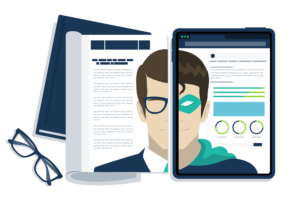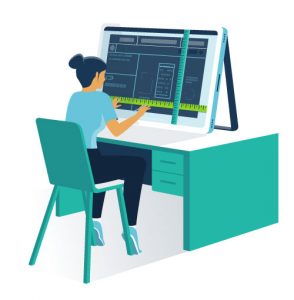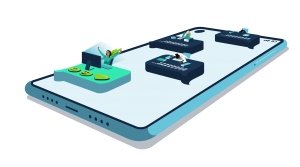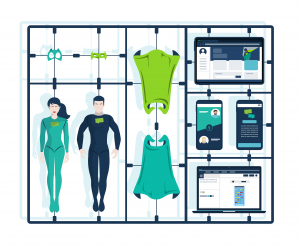Blended learning mixes traditional face-to-face training with online learning technology. As such, the more online learning has conquered the world, the more popular blended learning has become.
In fact, a report from 2016 identified blended learning as one of the most significant trends in the learning and development (L&D) landscape. And it’s not showing any signs of slowing down any time soon!
After all, blended learning comes loaded with benefits for organisations, educators and learners alike.
However, the global agreement on the effectiveness of blended learning is blurred by the ambiguity around its definition. With this in mind, our article delves into all the details and helps you to harness the power of blended learning.
Without further ado, let’s get exploring!
What Is Blended Learning?

Blended learning combines face-to-face learning and online learning activities into one harmonious learning experience. It can cover any training course that includes both an instructor-led element and an online learning element, as long as each part enhances the other.
It takes elements from each approach to create a varied and effective series of training interventions. As such, blended approaches do not simply duplicate course content and broadcast it online or swap analogue tools for digital ones.
Instead, traditional instructor-led elements give educators control over time, place, path and pace. Online activities, on the other hand, provide a more flexible and personalised experience.
By combining the two training delivery methods, blended learning can take advantage of diverse learning environments. These include, for example:
- Face-to-face classroom sessions
- Discussion groups
- Formal lectures
- Supervised online learning
- Self-paced distance learning
- Classroom-based computer sessions
Learners will explore some parts of the course in a traditional face-to-face setting with an instructor, while others take place online. This helps to maximise the educational impact for learners.
However, modern advances in technology have blurred the separation between face-to-face and online learning. Now, instructor-led sessions do not have to be in a classroom or face-to-face. Instead, instructors can supervise and support learners through online approaches such as video conferencing and live webinars.
Similarly, the split between online and in-person sessions is rarely the same for all courses or training needs. Instead, the key to effective blended learning courses lies in creating complementary training interventions hosted in a truly integrated learning environment.
Where Did Blended Learning Come From?
While the earliest references date back to the 1990s, blended learning has a relatively complex history. It evolved from the distance learning and open education movement. And some of the earliest examples of distance learning date all the way back to the early 1800s.
In fact, in the 1820s, Sir Isaac Pitman launched the first distance education course. Whilst this wasn’t a blended learning course, it did showcase a shift in focus. Learning was now taken to where the learner was, not the other way around.
When technology advanced in the 1960s and 1970s, training became more accessible. In fact, it was the first time organisations or educational institutions did not have to rely on printed materials or in-person classroom sessions. Some of the systems, like PLATO, are still around today!
Soon after, organisations started to take advantage of TV-based technology and CD-ROMs to deliver training experiences. As this delivery format could hold large quantities of information, it quickly became the ideal tool for distance learning.
Once the first learning management system was introduced in 1991, we saw the first generation of web-based teaching and training. Computers began to grow in accessibility and popularity, which allowed organisations and educational institutions to offer online training. All the necessary ingredients for a harmonious blended learning experience were now in place.
Blended Training Programme Design

The design of your blended learning programme depends heavily on the model(s) you use. However, there are some universal thoughts about the strengths and weaknesses of each classroom and online learning environment.
As such, before exploring some of the most common models in more in-depth, let’s have a look at what these learning environments are well suited for.
The Classroom Environment
In-person classroom training keeps the human element at the forefront. Instructors can take advantage of the visual feedback they receive from their learners while making the most of the classroom space.
In a nutshell, instructor-led classrooms are great for:
- Hosting guest speakers and industry professionals
- Discussions on abstract content
- Group discussions, roleplay and debates
- Sharing practical demonstrations
- Hands-on learning that takes advantage of specialised materials
- Presentations
- Providing feedback on complex activities
The Online Learning Environment
Online learning can be extremely effective if done right. The best eLearning programmes offer a platform for both individual self-paced learning and interactive and collaborative exploration of content and topics at hand.
The online learning environment can be useful for:
- Reading and asynchronous discussions
- Video and audio-based use cases and examples
- Gamified content and other interactive concepts
- Remote teamwork and collaboration
- Independent study, research and reflection
- Working on multimedia projects
- Knowledge checks using quizzes
- Providing instant, real-time feedback
The Different Blended Learning Models
Blended learning does not follow a predefined pedagogical approach. In fact, the possibilities are endless when it comes to different blended learning techniques.
There are hundreds of different models that vary in content, scale, technology and learning space. Each model is also different when it comes to instructional emphasis and the role of the educator.
There is some level of overlap between the various definitions and models. As such, each category is subject to interpretation, and all of them leave some room for flexibility. You can even combine several models into one blended approach!
In this section, we will explain some of the most common types of blended learning using descriptions and definitions that most educators know and use.
1. Flipped Classroom
The flipped classroom model is perhaps the most widely known version of blended learning. The model ‘flips’ the traditional roles of learning spaces.
In traditional training scenarios, learning usually takes place in face-to-face classroom settings. Learners then receive training material that they can explore outside the classroom to achieve a deeper level of understanding.
In flipped classrooms, learners get familiar with the learning content at home before working through it in instructor-led classroom sessions.
Typically, individual study happens online, while educator-led sessions take place in person. As a result, educators can support learners as they practise the concepts they learned independently.
By sharing additional context and examples during your classroom sessions, you can reinforce your learners’ knowledge. Similarly, these in-class exercises help you to troubleshoot any misunderstandings.
2. Flex Model
The flex model of blended learning is a self-paced and learner-driven approach. As the name suggests, this blended learning model is all about creating flexibility.
This means that learners proceed through training content on their own. Educators, on the other hand, focus on creating learning opportunities. They then support learners throughout the process as needed.
The support that educators provide can be to the individual themselves, a small group of learners or the whole learning community if appropriate. Regardless, the key point here is that the instructor is hands-on and will interact with learners as necessary.
As such, the flex model is best suited for learners who prefer learning independently. They are not tied to a specific schedule or place. In fact, most learning is delivered through online modules where learners move through an individually customised learning path at their own pace.
3. À La Carte Model
The à la carte model combines face-to-face classroom sessions with an optional online course. This online module can be taken up by learners according to their interests and needs.
The à la carte model allows educators to expand the study resources available to learners. As a result, together, these offer flexibility while boosting learner motivation and personalising their learning path.
In addition, this model can help to expand educational offerings beyond what your organisation or educational institution is capable of providing. After all, you can source additional resources from third-parties. As a result, it has become a highly popular blended learning model in higher education.
4. Self-Directed Model

In a self-directed blended learning model, learners use a combination of online and in-person training interventions to achieve their personalised learning goals. Seems like a typical blended learning approach, right?
The difference here is that self-directed learning focuses on learner initiative. Learners take responsibility for their training, tracking their progression and identifying needs and goals. As such, they need to be self-aware to understand what’s working and why and then adjust their approach accordingly.
While they attend in-class sessions like normal, learners also get access to additional eLearning content. This content explains topics in more detail and provides learners with the opportunity to put what they’ve learned into practice.
5. Supplemented Blended Learning
The supplemented blended learning model can comprise an augmented face-to-face or online approach. In this model, learners either complete online courses to supplement their regular face-to-face learning or participate in face-to-face sessions to enhance their online training programme.
As such, the emphasis is on supplementing. Your learners’ main training approach is supplemented with the opposite learning environment to cater for experiences that the dominant method cannot provide.
In other words, learners can enhance their classroom training with online learning or the other way around. As such, these environments do not get the same amount of learners’ time.
Supplemented blended learning helps you to provide demonstrations and examples in various contexts by truly taking advantage of the best of both worlds.
6. Station Rotation
Station rotation is one of the most popular blended learning approaches as it’s relatively easy to execute. In fact, 80% of elementary schools in California use the rotational model if they have adopted a blended learning approach.
With this model, learners rotate through various ‘stations’ on a fixed schedule. At least one of these stations is an online training course or activity. Other stations include, for example, face-to-face classroom sessions, online learning modules, 1:1 tutoring, homework assignments and group discussions.
Station rotation allows you to establish a controlled training schedule in the classroom while still leaving some flexibility for your learners. After all, they are able to take some control over the pace and path of their learning.
7. Lab Rotation

That brings us to the next model, called lab rotation. The lab rotation model is similar to the station rotation model as it allows students to rotate through different stations on a set schedule. The difference here is that learners access online learning experiences through dedicated computer labs.
These computer lab sessions are the only time learners access online learning activities. Instructors are present when these lab sessions take place. Other than that, learners explore topics through in-person teaching methods.
The lab rotation model still offers vast opportunities for flexibility as learners can access self-paced online learning activities. In addition, you can make use of your existing resources by putting those computer labs to good use!
8. Individual Rotation
The individual rotation model allows L&D professionals to rotate learners through different stations based on their individual training needs. They do so by following a set schedule.
As the name suggests, it’s similar to both station and lab rotation. However, unlike the other rotation models, learners do not necessarily rotate to every station. Instead, they only focus on activities scheduled for them based on their specific needs.
Similarly, learners attend instructor-led sessions based on their personal needs. One classroom session could include various students with different plans. As a result, each learner gets a different learning experience.
The individual rotation model offers an effective way to create bespoke development plans for each individual on a fixed schedule.
9. Mastery-Based Model
Mastery-based learning is a model where learners must demonstrate an in-depth understanding of a topic before they can progress onto another area. As such, learners can move at their own pace and follow a personalised learning timeframe.
In a blended learning setting, mastery-based models give learners vast amounts of independence. Learners can set their own learning goals and then choose the best approach in achieving them, whether it’s online or in-person.
To ensure you have the necessary understanding of your learners’ capabilities and skill levels, you need to focus on assessment design. Similarly, you need to provide activities that allow your learners to demonstrate their mastery and ability to solve problems in different contexts.
10. Inside-Out & Outside-In Models
The inside-out blended learning model is an approach where learning starts in the classroom, before finishing outside it – typically in a digital learning environment. The outside-in model, on the other hand, starts within a digital environment before finishing inside a classroom.
As such, in an inside-out model, learners first attend classroom sessions before moving to a more flexible online learning environment. The outside-in approach is the opposite. Classrooms are used at the end of the learning experience to share, collaborate and facilitate feedback.
With these models, the nature and content of classroom and online learning experiences is less important than their predefined order. They focus on platforms, spaces, people and opportunities beyond the traditional classroom setting.
The Benefits of Blended Learning
As blended learning combines the best aspects of both traditional and online learning, its power lies in its ability to enhance the learner experience. In fact, blended learning can reduce failure rates, improve knowledge retention and boost engagement.
As such, whether you are using blended learning to train your employees, partners or customers, you can reap many educational and economic benefits.
However, as we’ve seen, there are various blended learning models. These diverse methods are suitable for different learners and needs. And similarly, they may hold different benefits.
With this in mind, let’s take a closer look at some of the most common benefits individuals and educators can expect from a blended training programme.
Benefits for Educators & Organisations
Organisations and educational institutions alike can expect to see vast benefits after introducing and embracing blended learning. Combining your classroom and online learning activities into a harmonious learning environment enables, for example, better data insights, reduced costs and improved learner engagement.
Let’s go more into depth on the top five benefits!
1. Easier Tracking

Many blended learning tools allow educators and L&D professionals to track the performance of their learners effortlessly. This training evaluation gives you greater insight into which methods and activities are most effective.
You can identify what content your learners like the most by analysing which programmes and modules your learners are engaging with. This helps you to fine-tune your approach and create more effective learning units in the future.
To collect these data points, educators can take advantage of the real-time tracking possibilities most online learning solutions offer. For example, Growth Engineering LMS helps you to visualise each individual’s training journey.
This makes it easier to identify their strengths and weaknesses. Similarly, you can track who has or hasn’t completed their training. You can then nudge those who haven’t and encourage the others to keep progressing.
2. Improved Engagement
Better learning data often leads to enhanced engagement. After all, you can analyse all the metrics to see what programmes your learners are engaging with the most. This data is invaluable when it comes to boosting engagement.
By understanding where learner preferences and passions lie, you can cater to each individual. It’s much easier to engage with training content that is in line with our interests or needs.
Similarly, variety in training delivery and reinforcement material is key. Blended learning, by its very nature, supports a diverse range of training experiences. In fact, 59% of educators report that their students were more engaged to learn in a blended learning environment.
Why does this matter? Engagement doesn’t just mean more eyeballs on your content. It also has a great impact on individuals’ learning performance.
3. Tailored Approach

Did you know that in the US, every teacher has nearly 30 students to teach? The same goes for corporate training. Training is often delivered to the whole workforce, whether it’s 20 or 2,000 workers. As a result, it can be difficult to personalise sessions according to individual learner’s needs.
Luckily, blended learning can come to the rescue! You can create personalised online learning activities by gamifying your learning management system. For example, customised learning pathways allow each learner to follow a specific learning journey matching their individual training needs.
Analysing these results helps you to identify specific knowledge gaps. You can then focus in-class activities and support to meet your learners’ needs, strengths and weaknesses. Ultimately, this helps you to utilise your in-class time better.
Similarly, as we have explored, individuals have different preferences when it comes to training delivery and content types. With so many different learning styles to address, a blended solution helps you to cater to them all.
For example, social learners can thrive during live instructor-led classrooms or breakout discussions. Meanwhile, kinesthetic learners can get hands-on practice in different learning projects.
4. Reduced Costs
Blended learning has the power to reduce the costs associated with your training programme. After all, you can repurpose your content for different delivery mediums, which helps you to reduce the money spent on course preparation. Similarly, online learning content can be circulated multiple times.
77% of academic leaders believe that online learning is either as good or better than face-to-face training, while being delivered for a lower price. As blended learning takes advantage of online education, you can reduce some of the costs associated with in-class training. These include, for example, travel, accommodation, catering and printing costs.
And because blended learning is a more engaging, efficient and cost-effective way to train compared to traditional face-to-face sessions, you will see a greater return on investment (ROI). What’s not to love?
5. Variety of Contexts
Blended learning allows you to draw on a wide range of resources. This helps you to provide a vast library of training materials across different contexts. And this is extremely important!
Learners need to be able to adapt their knowledge and skills to different situations because new knowledge is fragile until learners do something with it.
Applying this knowledge to different situations and contexts is an excellent way to ensure your learners retain the information. In fact, providing your learners with multiple opportunities to manipulate and contextualise information promotes strong memory creation.
Blended training programmes take the best of both worlds and allow you to include various activities in different learning contexts. As a result, you can engage multiple areas in your learners’ brains, which helps you to create more interconnected neural networks.
Benefits for Learners
Blended learning does not benefit just your organisation or educators. Blended learning has the potential to provide a comprehensive training experience for your learners. And you will see increased retention and engagement as a bonus!
Let’s explore the five top benefits blended learning offers for your learners.
1. Flexibility
Blended activities introduce more flexibility than classroom-based learners have traditionally been accustomed to. Learners are empowered to take more control over the pace and the spaces in which they learn.
As such, those who are familiar with the topic can work their way through the material faster. On the other hand, learners who are less advanced can pause and re-watch tricky concepts to ensure full comprehension.
Similarly, your learners can easily access information at the point of need. This is especially true in a multi-device blended approach, where online learning activities work on all devices, including computers, mobiles and tablets. And let’s not forget that the younger generation is full of digital natives.
These modern learners are familiar with online environments and embody traits and needs that blended learning helps to meet. After all, it adds an immense amount of flexibility and fun into training. This helps learners to focus, absorb and internalise information better. Training has never been more accessible!
2. Enhanced Retention

Research on the effectiveness of blended learning in higher education suggests that blended training methods can help learners retain more information and gain a more comprehensive understanding.
Individuals tend to learn better when they combine passive study with different activities. These activities often include interaction and active experimentation. These approaches help learners share and compare knowledge and demonstrate different use cases.
Blended learning is an excellent way to ensure your training has both elements! By utilising different learning delivery methods, you can fill in any skills gaps left by a less optimal mode.
3. Collaborative Learning
Blended learning supports social learning. In fact, it does not only support it — it has the power to supercharge collaboration and communication by enabling both online and in-class social learning opportunities.
By enabling real-time online discussions using tools like Live Chat, Clubs and Social Feeds, learners can always access open channels of communication. As a result, you can provide constant support and learning opportunities for your learners.
And did you know that sharing knowledge increases creativity, learning and performance? In fact, an organisational culture with an emphasis on knowledge sharing improves productivity by up to 40%.
4. Accessible Content

Blended learning ensures that training material is available at all times. And having all these resources online ensures your learners can access the material with no constraints. They can learn when it suits them, instead of waiting for the next scheduled training session.
Learners can also prepare before face-to-face classroom sessions by exploring key topics online. This can be extremely useful in getting familiar with the materials and topics. And, of course, this means you can spend more time engaging in activities when your learners already have a basic understanding.
You can take content accessibility to the next level by making sure your online learning strategy takes advantage of microlearning. Learners can easily find time to complete training when they can do so in bite-sized chunks. After all, microlearning units typically take under 10 minutes to complete!
Microlearning content is the answer to maximising training time and effectiveness. In fact, it can increase information retention by up to 20%!
5. Taking Charge
Gone are the days when learners were content to simply sit in a classroom and listen. Blended learning allows learners to take control over their training. In fact, it moves learners from passive spectators to active participants.
Most corporate learners have time constraints when it comes to training as they balance workloads and their personal lives. Currently, employees can devote just five minutes per day to learning. A blended approach helps you to tackle this issue!
It can be used to encourage self-directed learning. In these cases, learners are instructed to explore and look for content independently, using their online learning tools.
As such, on top of your more focused classroom sessions, your learners can choose what content to explore and when. This kind of autonomy can be essential for success.
Final Words
It’s easy to understand why blended learning has become so popular in both education and corporate training! Combining online learning and in-person classroom activities can help learners, educators and organisations alike.
Once you have explored the different blended learning models and decided on your strategy, you need to ensure each element compliments the other. Luckily, our blended learning tip sheet will help you to do so!
Download ‘115 Tips For Blended Learning Success’ today and learn how to bring your traditional and online learning approaches together in perfect harmony.








